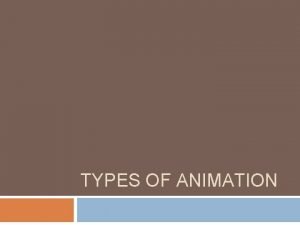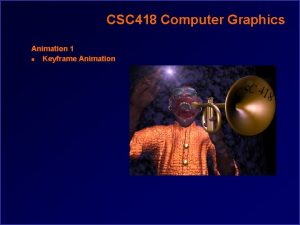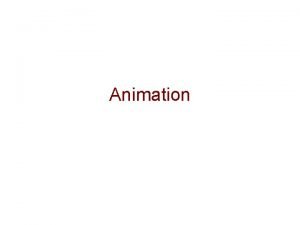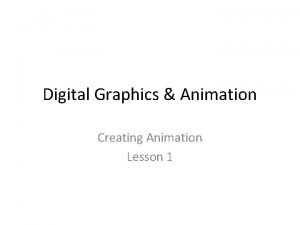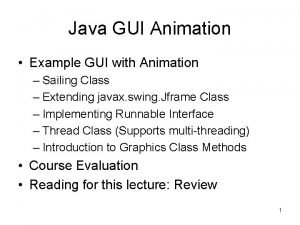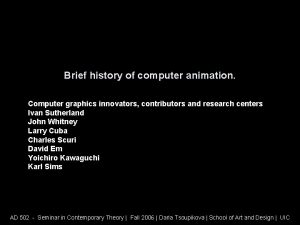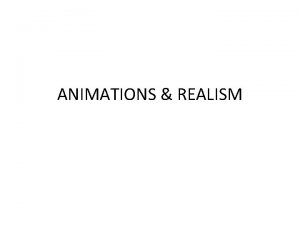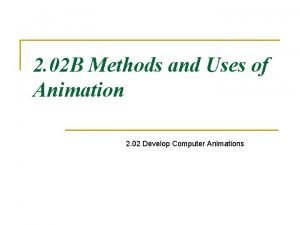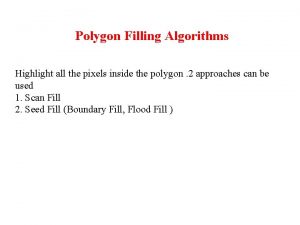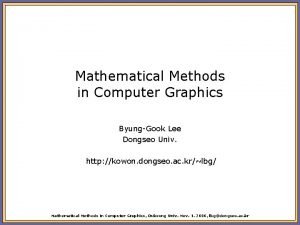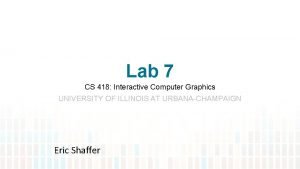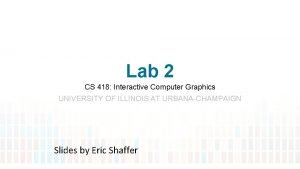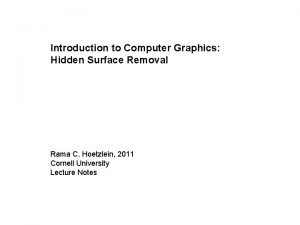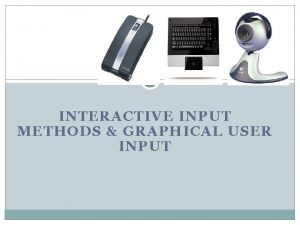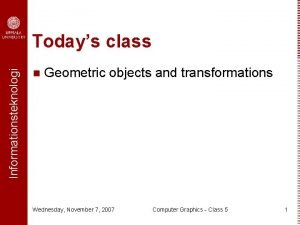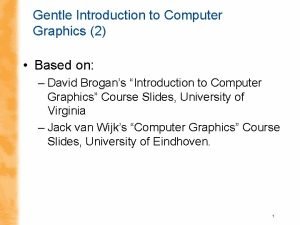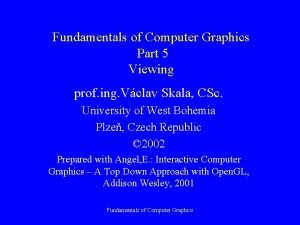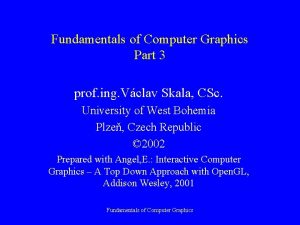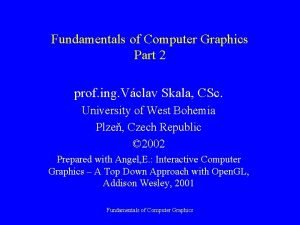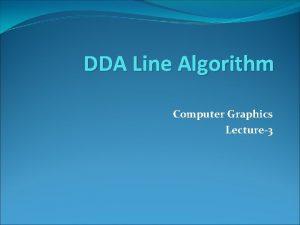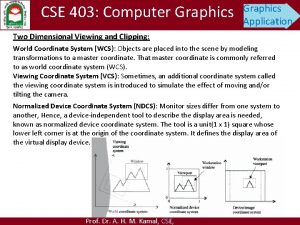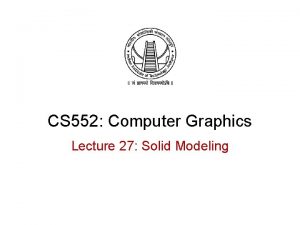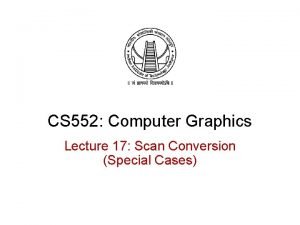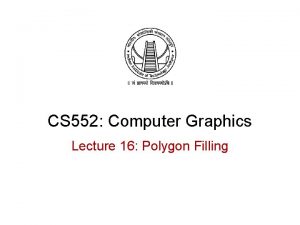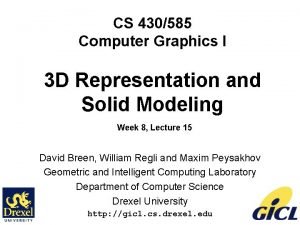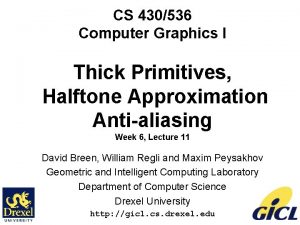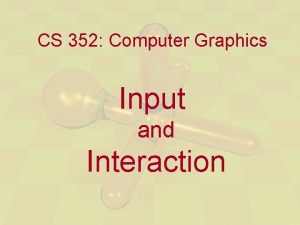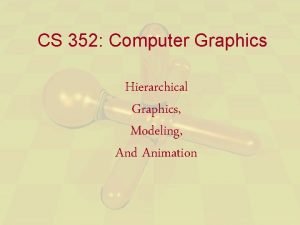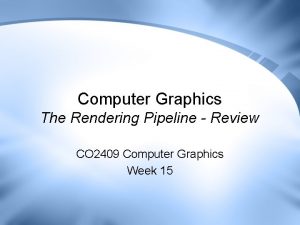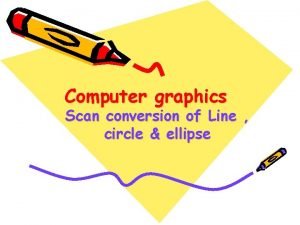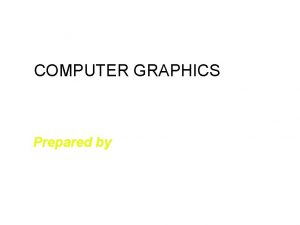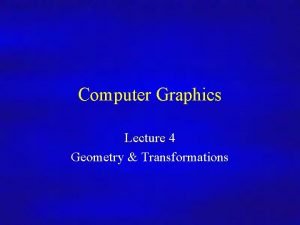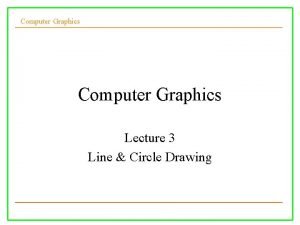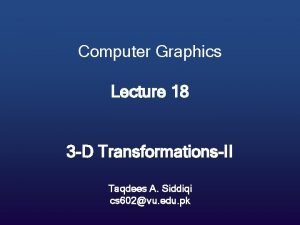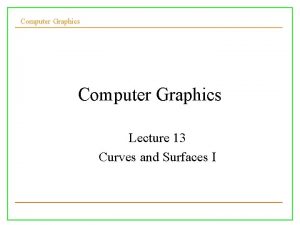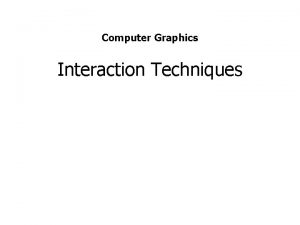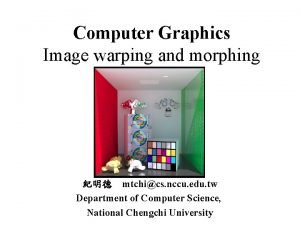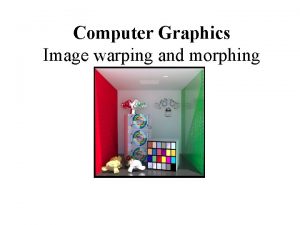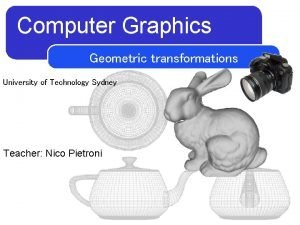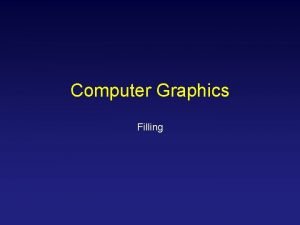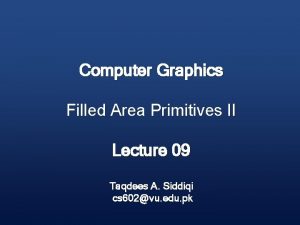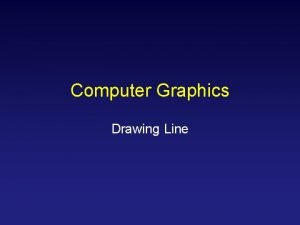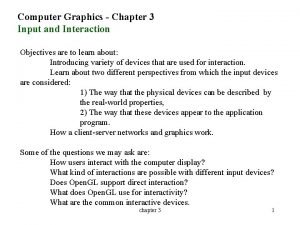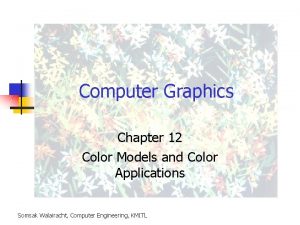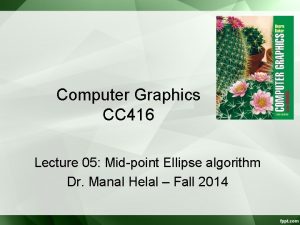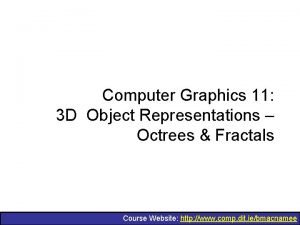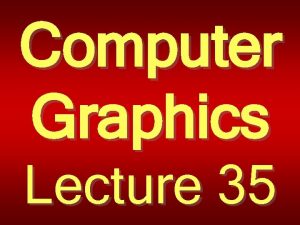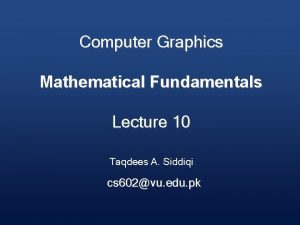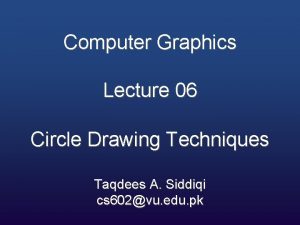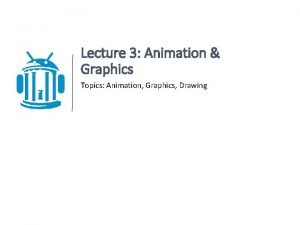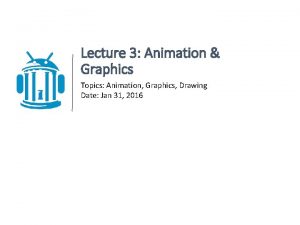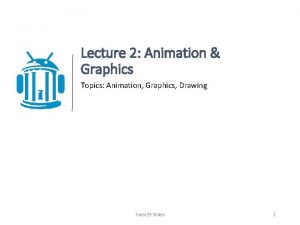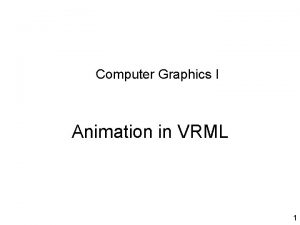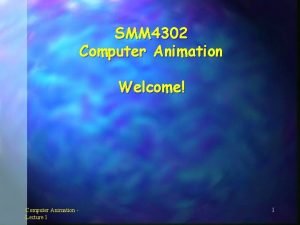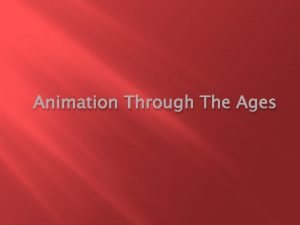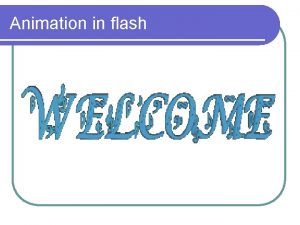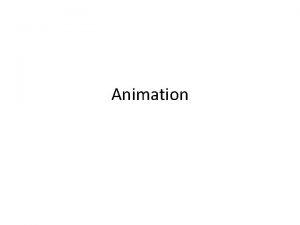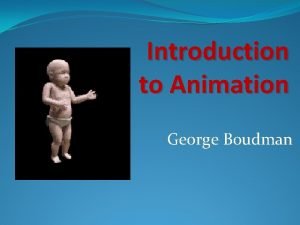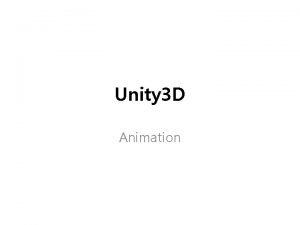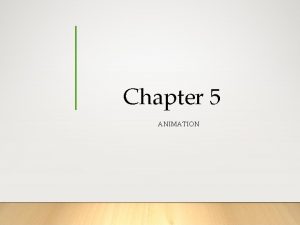Computer Graphics Lecture 45 Animation Taqdees A Siddiqi







































































- Slides: 71

Computer Graphics Lecture 45 Animation Taqdees A. Siddiqi cs 602@vu. edu. pk

The passage of time – a fascination for artists, scientists and theologians They have attributed to it different interpretations, implications & conclusions.

A general agreement on one aspect of time – - we are all conditioned by it and - there is a time space into which we have to fit

Einstein’s theory of relativity maintains that space and time are merely different aspects of the same thing. An inference by physicists - - objects can be moved backward and forward in space, but nothing can be moved back in time.

Another method of describing the concept of time is through the ‘three arrows of time’. Thermodynamic Historical ‘arrow’ Cosmological

Film Time – Vital concept to understand to use in Animation. – An essential raw material which can be compressed or expanded and – used for effects and moods in a highly creative way.

How time can be applied to animation? - the animator can creatively manipulate time - an action must be timed prior to carrying out the actual physical work on a film.

How the audience will react? Time sense is just as important as colour sense and skill of drawing or craftsmanship in film animation.

A performance on stage and on the screen requires a basic understanding of how timing works. However, we will consider hand drawn animation.

Timing for TV series

- Animation is expensive - TV series use simple minimum animation-Limited animation plots are carried along by means of dialogue prerecorded blocks of dialogue

The director has room to maneuver sections: Available Time = Total Time – Dialogue Time It can be split and distributed throughout the film

Limited Animation

24 frames per second required but: No more than 6 drawings used for one second of animation. Hold is lengthened

Animator skill required: for Limited animation = for Full animation

Full animation

Large number of drawings per second of action. May use 24 drawings per second of animation

Time and money not spared on animation. As a rule only TV-commercials and feature-length animated films can afford this luxury.

Animation is expensive and time-consuming. It is not economically possible to animate more than is needed and edit the scenes later, as it is in liveaction films.

In cartoons the director carefully pre-times every action so that the animator works within exact limits and does no more drawings than necessary.

Ideally, the director should be able to view line test loops of the film as it progresses and so have a chance to make adjustments. But often there is no time to make corrections in limited animation.

Timing for Animation in General

Timing in animation is an elusive subject. It only exists whilst the film is being projected, in the same way that a melody only exists when it is being played. A melody is more easily appreciated by listening to it than by trying to explain it in words.

So with cartoon timing, it is difficult to avoid using a lot of words to explain what may seem fairly simple when seen on the screen.

Timing is also a dangerous factor. The only real criterion for timing is: if it works effectively on the screen it is good, if it doesn't, it isn't.

Animation Principles

What is good timing?

GRAVITY Forces working against gravity Arrangement of Jointed body and muscles Psychological reason or motivation for action Live vs. lifeless objects

The Storyboard

A smooth visual flow is the major objective in any film, especially if it is an animated one. Good contin-uity depends on coordin-ating the action of the character, choreography, scene changes and camera movement.

The storyboard should serve as a blueprint for any film project No production should proceed until a satisfactory storyboard is achieved Creative & Technical issues must be addressed in advance

A rough guideline is approximately 100 storyboard sketches for each minute of film. For technically complex films, it may double

The Basic Unit of Time in Animation

The basis of timing in animation is the fixed projection speed of 24 frames per second (fps) for film and video. On television and video this becomes 25 frames per second (PAL) or 30 fps (NTSC), but the difference is usually imperceptible.

If an action on the screen takes one second it covers 24 frames of film, and if it takes half a second it covers 12 frames. This fixed number of frames provides the basis on which all actions are planned and timed by the director.

“The basic unit of time in animation”

For single frame animation, a second of action needs 24 drawings. If the same action is animated on double frames, 12 drawings are necessary the speed of the action would be the same in both cases.

The unit of time within which an animator works is, therefore, 1/24 sec, 1/25 sec or 1/30 sec and an important part of the skill, which the animator has to learn is what this specific timing ‘feels’ like on screen. With practice the animator also learns what multiples of this unit look like — 4 frames, 8 frames, 12 frames and so on.

Animation and properties of matter

The basic question which an animator is continually asking himself is: ‘What will happen to this object when a force acts upon it? ’. And the success of his animation largely depends on how well he answers this question.

Objects have their own weight, construction and degree of flexibility, different behaviour on application of force This behaviour - a combination of position and timing – is the basis of animation

Animation consists of drawings: no weight no forces acting are moving patterns have to be made to look live

Animators must consider Newton's laws of motion. Not verbal definitions but actual realization of these laws in action. Nothing moves automatically. Nothing stops suddenly.

The timing of a scene for animation has two aspects: The timing of lifeless objects The timing of the movement of a living character

With lifeless objects the problems are straightforward dynamics. ‘How long does a door take to slam? ’, ‘How quickly does a cloud drift across the sky? ’.

With living characters the same kind of problems occur because a character is a piece of flesh and a structure of jointed bones which has to be moved around by the action of forces on it.

In addition, time must be allowed for the mental operation of the character. He must appear to be thinking his way through his actions, making decisions and finally moving his body around under the influence of his own will power and muscle.

“Animation and properties of matter”

Animation consists of sequences of weightless drawings. The success of animation on the screen depends largely on how well these drawings give the impression of reacting in an exaggerated way when weight and forces are made to act upon them.

Movement and Caricature

“Movement and caricature”

Cartoon is a medium of caricature. Naturalistic action looks weak in animation. Look at what actually happens, simplify down to the essentials of the movement and exaggerate these to the extreme.

Cause and Effect

The strength of the forces pulling the rope The flexibility or rigidity of the object being squeezed. Exaggerate the tendency

Fig A: A rope wrapped around something

Fig B: The ends of the rope are pulled tight

Looking back History Devices Drawing Primitives – Point – Line – Circle – Ellipse

Area Filling – Polygon Filling – Scanline Fill – Boundary Fill – Flood Fill – 4 -Connected vs. 8 -Connected

Mathematics – Matrices – Vectors – Matrix Operations – Vector Operations

2 -D Transformations – Translation – Rotation – Scaling – Reflection – Shear – Homogeneous Coordinates

Clipping – Point – Line – Polygon – Filled Polygon

3 D Concepts 3 D Transformations – Translation – Rotation – Scaling – Reflection – Shear – Homogeneous Coordinates

Projection Parallel Projection Perspective Projection Triangles and Planes Triangle Rasterization

Light Color Lighting and Shading Types of Lighting Equation Lighting Models

Light Color Lighting and Shading Types of Light Directional Positional

Components of Light Ambient Diffuse Specular Back-Scattering

Open. GL Introduction Architecture Advantages GLUT Open. GL Programming Examples

Curves Plane Curves Space Curves Bezier Curves Surfaces and Subdivision Icosahedron

Fractals Open. GL – Lighting Open. GL – Viewing Open. GL – Modeling Open. GL – Curves Open. GL – Surfaces Open. GL – Evaluators

Fractals Open. GL – Lighting Open. GL – Viewing Open. GL – Modeling Open. GL – Curves Open. GL – Surfaces Open. GL – Evaluators

Computer Graphics Lecture 45
 Faraaz siddiqi
Faraaz siddiqi Traditional animation vs computer animation
Traditional animation vs computer animation Csc418
Csc418 Animation meaning in computer
Animation meaning in computer Graphics monitor and workstation in computer graphics
Graphics monitor and workstation in computer graphics Graphics hardware in computer graphics ppt
Graphics hardware in computer graphics ppt Digital graphics and animation
Digital graphics and animation Java gui animation
Java gui animation 01:640:244 lecture notes - lecture 15: plat, idah, farad
01:640:244 lecture notes - lecture 15: plat, idah, farad History of computer animation
History of computer animation Motion specifications in computer graphics
Motion specifications in computer graphics What is path based animation
What is path based animation Computer security 161 cryptocurrency lecture
Computer security 161 cryptocurrency lecture Computer aided drug design lecture notes
Computer aided drug design lecture notes Architecture lecture notes
Architecture lecture notes Isa definition computer
Isa definition computer Angel computer graphics
Angel computer graphics What is viewing in computer graphics
What is viewing in computer graphics Display devices in computer graphics
Display devices in computer graphics Two dimensional viewing
Two dimensional viewing Shear transformation in computer graphics
Shear transformation in computer graphics Shader computer graphics
Shader computer graphics Define scan conversion in computer graphics
Define scan conversion in computer graphics Rigid body transformation in computer graphics
Rigid body transformation in computer graphics Region filling
Region filling Advantages and disadvantages of scan line fill algorithm
Advantages and disadvantages of scan line fill algorithm Boundary fill algorithm
Boundary fill algorithm What is raster scan display
What is raster scan display Computer graphics
Computer graphics Line drawing algorithms
Line drawing algorithms Cs 418
Cs 418 Glcreatebuffer
Glcreatebuffer Depth sorting method in computer graphics
Depth sorting method in computer graphics Achromatic light in computer graphics
Achromatic light in computer graphics What are the interactive input methods? explain in detail.
What are the interactive input methods? explain in detail. Uniform scaling in computer graphics
Uniform scaling in computer graphics Uniform scaling in computer graphics
Uniform scaling in computer graphics Fundamentals of computer graphics
Fundamentals of computer graphics Logical input devices in computer graphics
Logical input devices in computer graphics Sierpinski gasket in computer graphics
Sierpinski gasket in computer graphics Points and lines in computer graphics ppt
Points and lines in computer graphics ppt Pixel addressing in computer graphics
Pixel addressing in computer graphics Dda computer graphics
Dda computer graphics Normalized device coordinate
Normalized device coordinate Primitive instancing in computer graphics
Primitive instancing in computer graphics Scan conversion in computer graphics
Scan conversion in computer graphics Flood fill algorithm in computer graphics
Flood fill algorithm in computer graphics Boundary representation in computer graphics
Boundary representation in computer graphics Thick primitives in computer graphics
Thick primitives in computer graphics Interaction in computer graphics
Interaction in computer graphics Computer graphics
Computer graphics Computer graphics pipeline
Computer graphics pipeline What is the basis of scan conversion of a circle
What is the basis of scan conversion of a circle Srgp in computer graphics
Srgp in computer graphics Transformation computer graphics
Transformation computer graphics Midpoint line drawing algorithm in computer graphics
Midpoint line drawing algorithm in computer graphics Uniform scaling in computer graphics
Uniform scaling in computer graphics Computer
Computer Input techniques in computer graphics
Input techniques in computer graphics Edge table in computer graphics
Edge table in computer graphics Warping in computer graphics
Warping in computer graphics Morphing and warping in multimedia
Morphing and warping in multimedia Frame yv
Frame yv Active edge table
Active edge table Filled vs unfilled polygon in computer graphics
Filled vs unfilled polygon in computer graphics What is object lines?
What is object lines? Character attributes in computer graphics
Character attributes in computer graphics Objectives of computer graphics
Objectives of computer graphics Hsl color model in computer graphics
Hsl color model in computer graphics Pixmap in computer graphics
Pixmap in computer graphics It is the midpoint of ellipse inside the curve
It is the midpoint of ellipse inside the curve Types of fractals in computer graphics
Types of fractals in computer graphics

